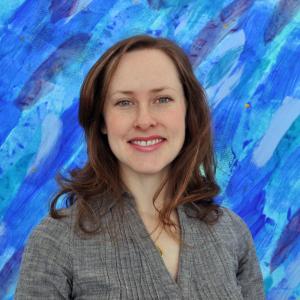Collage Birds Inspired by Picture Books
Here is a deep look into one of the projects we did with our Animals, Art and The Imagination 2013 Students, aged 6-10, on the final day of our program.
To me, the strength of this project is that it involves a few different kinds of activities to appeal to many kinds of learners:
- Open-ended time to move about the room and explore materials (in this case to explore color and visual texture)
- Comparison and conversation about the works of multiple picture book artists.
- Combining memory with imagination, and creative, problem solving, and fine motor skills.
The project happened in a few phases throughout the day. In the morning, I set up a series of stamping stations with our homemade tempera paint stamp pads, similar to when we do our Eric Carle program offsite. I let the students make as many visually-textured papers using tracing paper, construction paper and Folia Transparent Paper as they wished within a 30 minute period.
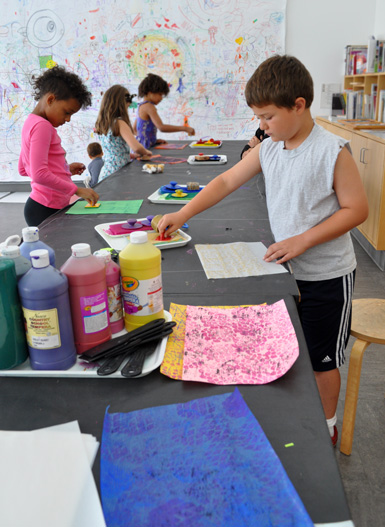
When the students were stamped out, we gathered in a circle on the floor around a handful of picture books to look at how different artists’ illustrate birds. The students observed that some artists work realistically, depicting the birds and their details closely to how we would see them in nature, and some artists work more abstractly, using a collection of basic shapes to illustrate theirs.
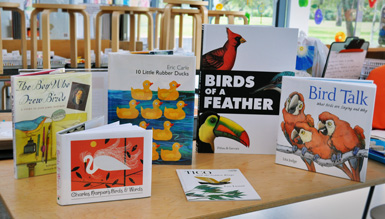
We looked carefully a doodle of the Pigeon, which happened to be drawn by Mo Willems himself in larger-than-life fashion on our back wall. When we compared Pigeon with birds by Charley Harper and Eric Carle, the students noticed that there were a few basic geometric shapes the artists used in common: tear drops/seed, circles, and triangles. We used magnetic versions of those shapes on a small magnet board to collectively construct a bird of our own as I told them that later, they would be making their own birds out of paper.
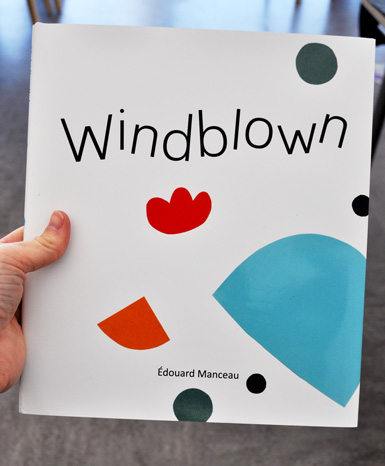
After a storytime in the Reading Library featuring books with birds, an Elephant and Piggie story, and Windblown by Edouard Manceau, I gave each student a rectangle, approximately 6”x10” of heavy paper (like cardstock) and proposed that we make our own collage birds. Those who were less excited about the idea were glad to hear that after making a bird, they would be welcome to construct a flying creature of their choice.

I explained that we would be cutting our birds’ parts out of the white paper first and then adding our stamped paper to our shapes once we were happy with them. I suggested they start by cutting out the largest part of the bird. While asking them to remember what shape Mo Willems, Eric Carle, and Charley Harper often used for the body of the bird, I cut a rough tear drop from my own piece of paper, starting with the point on one of the short sides. Whenever possible I try not to “demonstrate” how to do something because it could lead the the students to wanting theirs to look like mine, or feelings of not getting theirs “right.” I let them know if they want to make their drop rounder, or wider or narrower, they choice was theirs. As it turns out, everyone’s drop shape was unique. As an educator, I see a part of my job as helping my students see their peers as resources and teachers. I’ve since done this project again ans asked a student to show the rest of the group how they might cut a tear-drop shape.
When everyone had cut their bird’s body shape, I had them hold up their negative shape (the paper leftover from their drop shape) to see if there were other shapes within it they could identify. They found that 2 triangle-ish shapes were left down by the point-end of my paper. As I showed them how I cut triangles off my negative shape I asked “what parts of my bird could use these for?” Their responses included “wings”, “a tail”, and “a beak” and showed me that they could each envision a unique way to create their bird.
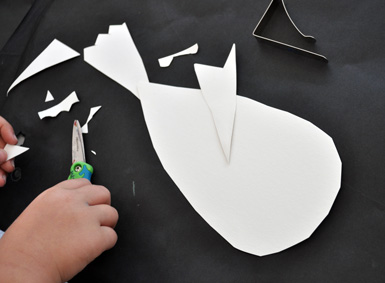
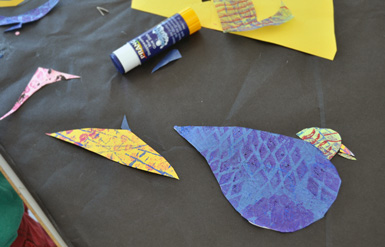
Once nearly everyone had their shapes cut out, we talked about how to integrate their stamped collage papers into their birds. We could have gone directly to cutting shapes out of their collage paper, but my thinking was that cutting from the white paper would help them focus on they shapes they were making without the distraction of color and visual texture. Additionally, my plan was to invite the students to make a mobile with their birds. It would be necessary to have the final birds be sturdier than just the papers we stamped. So, using one of my white shapes and a gluestick, I showed them how to glue it to the back of a stamped paper and then cut it out again. The parts of the birds were glued to each other rather than a background piece of paper. Everyone finished at least one bird. A few who had extra time started making bats. Next time I do this, I might having them stamp directly to heavier weight paper to save the extra gluing and cutting step. I liked how “drawing with scissors” (as opposed to drawing the shapes on the papers with pencil first) helped keep the shapes loose and large. Sometimes, when given a pencil, or “precious” materials such as their stamped papers, kids have a tendency to work really small.
Later, we attached our birds to sticks we collected on our walk with craft string and white file-label dots. This is the part of the process I have no photos of. You can’t always be in the moment and document it! The shot I would have loved for you to see is of the students running around outside, birds flying behind them. This is my own stationary bird hung in The Studio after the fact.

White glue and strong tape would have worked better than for the final assembly of bird parts and string. On a breezy day, birds must fly! Gluesticks and dot stickers were not enough to hold together birds flown with the energy of a child on their last day of camp of the whole summer. So, a few repairs had to be made.
This exploration’s structure is one I’ll use with different themes and books again and again! In your home or classroom the components could be spread across a couple days. Maybe your child is into dinosaurs, or buildings, or flowers? Have fun adapting this idea with picture books and ideas that interest them!

